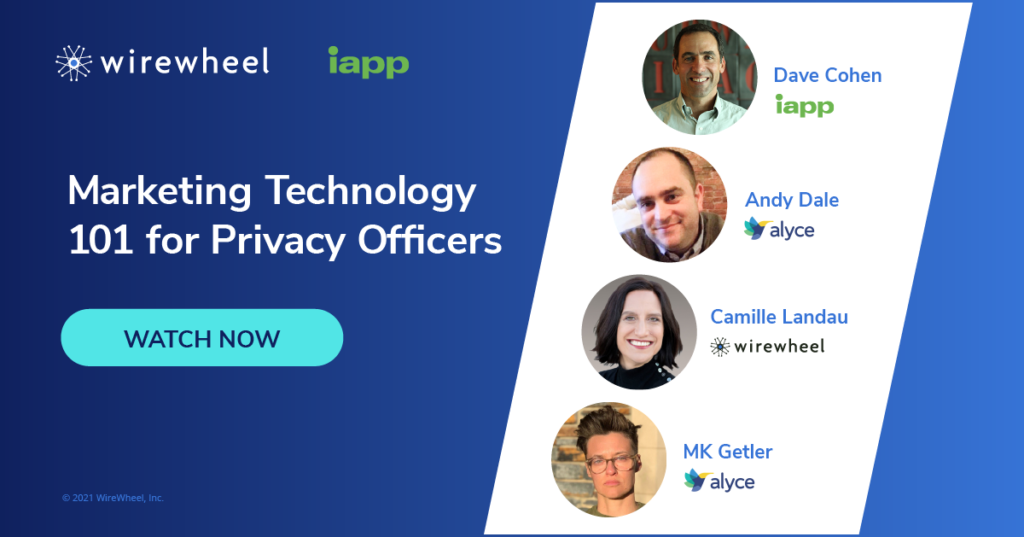Marketing Technology 101 for Privacy Officers: What Is the Marketing Team Up To?
• read

A marketer has to balance all of the tools that they’re going to deploy and utilize all of the data at their fingertips. But they more and more have to be really attentive to their brand and their brand’s reputation. And…data they’re utilizing, and the ways in which they’re utilizing that data, have become subject to scrutiny. Become subject to privacy laws.
—Andy Dale
Privacy officers and policy wonks are of course familiar with this “scrutiny” and the consequent data privacy regulations to which Dale, the General Counsel and Head of Strategic Partnerships at Alyce refers: namely the General Data Protection Regulations (GDPR), the California Consumer Privacy Act (CCPA), and the recently passed California Privacy Rights Act (CPRA), colloquially referred to as CCPA 2.0.
And while privacy officers are likely familiar with the machinations of AdTech – employing first-, second-, and third-party data leveraging cookies, Facebook pixels, and myriad re-targeting schemes to follow consumers on- and off-line activities — privacy officers may be less familiar with the vast marketing technology (“martech”) ecosystem, which includes (and leverages) AdTech, to find and communicate with consumers. Marketing activities that have now fallen under “scrutiny” as consumers and regulators alike consider their ethical and privacy rights implications.On February 9, the IAPP Webinar Marketing Technology 101 For Privacy Officers hosted by IAPP’s knowledge manager, Dave Cohen was moderated by Dale. Andy was joined by Alyce’ Head of Marketing, MK Getler and WireWheel Chief Marketing Officer Camille Landau.
The Martech Stack
At the risk of oversimplification, the marketing technology stack is fundamentally the collection of software solutions used by marketers to find and communicate with existing and potential consumers. The collection of tools your company chooses (i.e., the stack), includes those necessary to reach current and prospective consumers: to plan, execute, manage, and analyze the value of your advertising and marketing strategy. Naturally, as with all technology, the solutions your company deploys will change and grow over time as both the technology and your company’s marketing efforts evolve.
As Alyce’s Getler notes, the martech stack comprises an enormous selection of solutions.
To solve core business problems, marketers are prone to add technology as the solution. Especially when marketers are trying to balance both their outbound marketing and inbound marketing motions. [1] It becomes clear and very obvious that folks are using technology to help build better efficiency in their processes. And as the space has evolved, what’s really interesting is that today we have 8,000 solutions available to marketers.
—MK Getler
The growth of martech has been nothing short of remarkable over the last ten years.
As detailed in Marketing Technology Landscape Supergraphic (2020), which caused quite a stir among the webinar attendees, there were fully 8,000 solutions available in 2020 (The author notes that this is a pre-pandemic survey). To fully appreciate the rate of growth, consider that there were approximately 150 martech solutions in 2011, 1,000 in 2014, and 5,000 in 2017.
This robust landscape divides into six categories:
- 922 advertising and Promotion or “AdTech” (e.g., search and programmatic advertising) solutions
- 1,926 content solutions from email to video, and mobile
- 1, 969 social and Relationship solutions like loyalty programs and social media marketing and monitoring
- 1,314 commerce and Sales platforms like sales automation and e-commerce marketing platforms
- 1,258 data solutions to compile and analyze things such as marketing data and consumer intelligence, and
- 601 management platforms for project and workflow management, collaboration, and budget management.
What should a privacy officer make of all this?
Underneath it all, marketers are trying to triangulate all of the respective data points that are [the] customer journey across all of these solutions. So, as you look at a marketer’s world today, all of these point solutions solve individual problems…and being able to wrangle and maintain data, and data accuracy, is probably one of the most difficult parts of any marketer’s job today.
When you think about selecting the right technology and partnering with the members of your data compliance and your privacy team in-house, the underlying thing that you’re trying to preserve is operational alignment, good data integrity, and hygiene.
—MK Getler
Importantly, as MK goes on to caution, “your marketing team needs to rely very heavily on their legal and/or compliance teams to make sure that they’re following all the right protocol. That they’re following all the right procedures. And that all 8,000 of the tools are speaking to each other, [passing along individual consumer opt out and opt in signals, and] maintaining data integrity across these platforms.”
As Much Science as Art
The scope of marketing has changed. For the marketing savvy organization, gone are the days of the marketing-sales silos and hand-offs. Now “marketers are stretching themselves across the entire customer lifecycle,” says Getler. “We are now not only responsible for net-new acquisitions. We’re responsible for retaining customers as well [and] thinking about increasing the lifetime value of a customer.”
To support customer retention programs and even begin to comprehend customer lifetime value, the traditional marketing arts are very much now imbued with data science. To do this, says MK, means “making sure you’ve kept your data, all your hygiene, all of your opt-in or regulations clean and tidy.” This is “becoming a really important part of what marketers are responsible for today.” And this requires a close working relationship across the organization including the privacy team, InfoSec, Legal, et al.
And then of course like any good marketer, our job is to always analyze and optimize. These days marketers are a lot more scientists than they are arts and crafts and creative. And so, the analysis and optimization of solving your problems or introducing technology to help alleviate those problems is becoming…one of the most important [aspects of] a modern-day marketer’s life.
But now you’re going to need to understand how to actually apply that technology into a sound marketing strategy.
—MK Getler
And fundamentally, the strategy will likely be designed to enhance customer lifetime value (CLV).
Trust is the Common Language of Privacy and Marketing
The end goal is customer lifetime value, which really boils down to how much value is our organization offering our consumer base and how much more value might we be able to offer and be rewarded for monetarily. That has to do with fit of product, it has to do with being able to serve customer’s ongoing needs, [and] deepen that relationship.
So ultimately it is about a trusting…And I think that trust is the common language that can and should be shared between privacy and marketing.
—Camille Landau
The marketer’s job has been complicated by the changing opinions concerning third-party data around which the vast preponderance of digital advertising and marketing campaigns have been designed. Now that third-party data have seemingly become ‘personas’ non grata – particularly with the steps being taken by Apple and Google – it is not that AdTech goes away per se, but rather, the methodologies for understanding your own and prospective consumers must change: not simply to be compliant, but to be effective marketers.
“What I want to stress…is that there is so much opportunity for an organization to deepen its relationship with customers, prospects, and existing customers through first party means…customer research can be done directly…” says Camille. “Typically, one learns much more from direct exchange with customers as opposed to relying on approximation from Facebook.
“If a goal, which it typically is, top of funnel leads, one can get direct customer referrals as opposed to working with list brokers” reminds Landau.
Where Do We Go from Here?
Evaluate technology as to whether it helps the organization genuinely understand and serve the needs of prospects and customers. The more we know our customers, the less reliance we’ll have on third parties to essentially guess for us… a mature technology stack is one that helps us increase our ability to know and to serve our customers.
—Camille Landau
As Greek philosopher Heraclitus instructed (c. 500 BCE) “the only constant is change.” And the marketing ecosystem is certainly changing. The martech ecosystem continues to evolve, the AdTech industry is in crises, privacy regulations are continually being considered in the U.S. (most recently in Virginia) and perhaps most notably consumer attitudes are evolving and making themselves heard with spending decisions.
But as Camille stresses “While virtually everything is changing all the time…The thing to keep in mind, again, is what is the goal?
The goal is great customer experience. What are the elements of customer relationship we would like towards that goal? Then the technology should plug in.”
IAPP host, Dave Cohen, asks “as marketing tech is being evaluated, are there any tips or structures to keep the relationship between privacy counsel and marketing a partnership rather than adversarial?”
MK offers the insight that “right now, marketers know that most of the technology and most of the tactics they’re using to drive a strategy are table stakes. Digital advertising: it’s table stakes right now.
What they don’t understand though, is the implication of using this technology, and the implication that that technology has on compliance and regulatory issues.”
And so, to have a symbiotic relationship between your legal and privacy teams and your marketing team starts first and foremost with education. Marketers are going to need your help being educated on their social responsibility of managing the data and the data flow properly and the privacy of the contacts in their contact database…Never assume that a marketer understands why this type of information, why this type of regulation is so important which makes me a better [data privacy] steward.
—MK Getler
“So, start there.”
[1] Inbound Marketing is an approach that seeks to pull in customers and prospects through engaging content perceived as valuable by the consumer. Conversely, outbound Marketing pushes out a message indiscriminately, such as traditional advertising intended for a mass audience. Outbound marketing is from the seller’s perspective. Inbound marketing adopts the consumer’s perspective (when done well).
Watch the Marketing Technology 101 for Privacy Officers Webinar Replay





